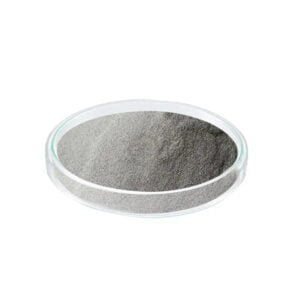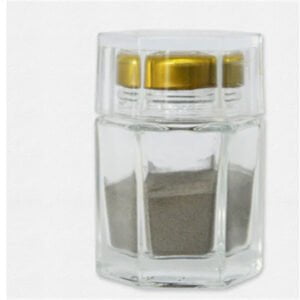316 Metal Powder
Table of Contents
316 metal powder is a type of stainless steel powder composed primarily of iron, chromium, nickel, and molybdenum. It is widely used in various powder metallurgy, additive manufacturing, and metal injection molding applications due to its excellent corrosion resistance, good mechanical properties, and ability to be 3D printed or sintered into complex parts.
Overview of 316 Metal Powder
316 metal powder, also known as 316L stainless steel powder, provides high strength and durability alongside unmatched resistance to corrosion and oxidation. Here is an overview of 316 powder:
| Properties | Details |
|---|---|
| Main Components | Iron, Chromium, Nickel, Molybdenum |
| Grade | 316L |
| Key Characteristics | Excellent corrosion resistance, good mechanical properties, high hardness and strength, excellent weldability and formability |
| Common Industry Applications | Aerospace, chemical processing, oil and gas, automotive, medical devices, tooling |
| Popular Manufacturing Processes | Metal injection molding (MIM), Direct metal laser sintering (DMLS), Binder jetting, Hot isostatic pressing (HIP) |
With the right parameters and processing methods, 316 metal powder can be turned into highly complex and durable parts thanks to modern manufacturing techniques.

316 Metal Powder Composition
316 stainless steel gets its corrosion resistant properties from the presence of chromium, nickel and molybdenum alongside iron. Here are the typical composition ranges:
| Element | Composition Range |
|---|---|
| Iron (Fe) | Balance |
| Chromium (Cr) | 16.00 – 18.00% |
| Nickel (Ni) | 10.00 – 14.00% |
| Molybdenum (Mo) | 2.00 – 3.00% |
| Manganese (Mn) | 2.00% max |
| Silicon (Si) | 1.00% max |
The balance is iron alongside trace amounts of carbon, phosphorus, sulfur and nitrogen. The exact proportions may vary between different 316 metal powder manufacturers and grades.
The high chromium and nickel content gives 316 stainless its excellent corrosion resistance. Molybdenum further enhances these properties, especially resistance to pitting and crevice corrosion in harsh environments. Manganese and silicon also play pivotal roles in forming the steel microstructure.
Properties of 316 Metal Powder
Thanks to its specialized composition, 316 stainless steel powder delivers a well-rounded set of mechanical, physical and chemical properties that make it suitable for high-performance applications:
| Property | Details |
|---|---|
| Density | Approximately 7.9 g/cm3 |
| Melting Point | 1375-1400°C or 2510-2550°F |
| Ultimate Tensile Strength | 515 to 620 MPa |
| Yield Strength | 170 to 310 MPa |
| Modulus of Elasticity | 193-200 GPa |
| Elongation at Break | 40-50% |
| Hardness | Max 4 in HRB scale |
| Corrosion Resistance | Excellent, withstands chlorides, acids, saline media |
| Heat Resistance | Good heat resistance up to 870°C for short periods |
| Magnetism | Non-magnetic in annealed condition |
These properties make 316 ideal for structures needing high strength, toughness, formability as well as resistance to severe corrosion and extreme temperatures. Parts maintain integrity even when exposed to acids, chlorides, sulfides and salt water making it suitable for ocean, chemical and heat applications.
Applications of 316 Metal Powder
Thanks to its well-balanced material properties, 316 stainless steel powder is extremely versatile and used across many critical industries. Some major applications include:
| Industry | Applications |
|---|---|
| Aerospace | Engine parts, landing gear components, hydraulic tubing, fasteners, braces |
| Oil & Gas | Valves, wellheads, downhole tools, offshore rigs, heat exchangers |
| Automotive | Chassis parts, exhaust manifolds, clamps, nuts, bolts, valves |
| Chemical | Tanks, process vessels, piping, pumps, valves, reaction chambers |
| Medical | Surgical tools, implants, hypodermic tubing, biopsy forceps, clamps |
| Food & Beverage | Mixing vessels, tubing, valves, fittings, fasteners, machine parts |
316 steel resists corrosion cracking and performs well under prolonged exposure to acids, salts and oxidizing chemicals making it suitable for the harshest conditions. It also provides the strength crucial for structural components.
316 Metal Powder Specifications
316 stainless steel powder is available in various size distributions, shapes and formats based on the requirements of the application and manufacturing process:
| Attribute | Details |
|---|---|
| Sizes | 10-45 microns common but submicron to 150 micron sizes possible |
| Size Distribution | Various ranges possible based on mesh cuts |
| Morphology | Spherical, angular and mixed shapes available |
| Formats | Feedstock, precursor powder, loose powder, granulated |
| Standards Compliance | ASTM A240, ASME SA 240, EN 10088 |
| Certifications | ISO 9001, ISO 14001 |
Chemistry, size distribution, morphology and shape can be customized based on targeted application, manufacturing process requirements and final part specifications.
Manufacturing Using 316 Metal Powder
316L powder possesses excellent manufacturability owing to its corrosion resistance and weldability alongside good ductility and formability. Some key manufacturing processes that utilize this stainless steel powder include:
| Process | Overview |
|---|---|
| MIM (Metal Injection Molding) | Mixing metal powder + binder into a feedstock, injection molding then sintering |
| DMLS (Direct Metal Laser Sintering) | 3D printing process using lasers to fuse metal powder into complex shapes |
| Binder Jetting | Printing a liquid binding agent onto metal powder bed to form parts layer by layer |
| HIP (Hot Isostatic Pressing) | High temperature and pressure used to eliminate porosity and increase density |
316L powder can also be consolidated into billets and parts using standard powder metallurgy techniques followed by secondary machining, finishing, welding, surface treatments etc.
Advantages and Limitations of 316 Metal Powder
316 stainless steel powder provides an unparalleled balance of properties for high demands alongside great manufacturing versatility through processes like metal 3D printing. However, there are also limitations.
| Type | Details |
|---|---|
| Pros | Excellent corrosion resistance, good strength and hardness, great manufacturability and weldability, can be 3D printed into complex geometries |
| Cons | Less formable than austenitic grades, prone to carbide precipitation at high temperatures affecting corrosion resistance and ductility, expensive compared to carbon steels |
For most applications, the advantages of 316 powder outweigh limitations making it popular for critical components across industries.
Suppliers of 316 Metal Powder
316 stainless steel powder for metal AM, MIM feedstocks etc. is commercially available from various global material suppliers. Some options:
| Supplier | Grade | Size (μm) | Form |
|---|---|---|---|
| Sandvik | 316L | 10-45 | Spherical, premixes |
| TLS Technik GmbH | 316L | 10-63 | Gas, water atomized |
| Carpenter Additive | 316L | 15-45 | Plasma atomized |
| Erasteel | 316L | 20-150 | Water atomized |
| Praxair | 316L | 10-75 | Gas atomized |
Producers use gas atomization, water atomization, plasma atomization etc. to make 316 powders with customized sizes, shapes and distributions for different applications.

316 Metal Powder Pricing
The price of 316 stainless steel powder varies based on chemistry, size, shape, quantity ordered, supply-demand dynamics and other factors. Here are some approximate cost ranges:
| Type | Size (μm) | Price Range |
|---|---|---|
| Spherical, gas atomized | 15-45 | $25-45 per kg |
| Angular, water atomized | 20-63 | $15-35 per kg |
| Spherical, plasma atomized | 10-75 | $30-100+ per kg |
Premium charges for special size distributions, shapes, chemistries, tighter tolerances and certifications. Powder metallurgy grade 316L metal powder costs less than varieties optimized for additive manufacturing.
FAQs
| What is 316 metal powder? | 316 metal powder is a type of corrosion resistant stainless steel powder primarily composed of iron, 16-18% chromium, 10-14% nickel, 2-3% molybdenum and trace amounts of other elements. |
| What is 316 stainless steel powder used for? | 316 powder sees widespread use across aerospace, oil & gas, chemical processing, automotive and medical sectors owing to its excellent corrosion resistance combined with good mechanical properties. |
| What is 316L stainless steel powder? | The L designation indicates low carbon content (0.03% max). 316L powder possesses the same corrosion resistance as 316 but superior weldability and resistance to carbide precipitation during high temperature applications. |
| What manufacturing processes use 316 metal powder? | 316 powder sees use in metal injection molding (MIM), direct metal laser sintering (DMLS), binder jetting, hot isostatic pressing (HIP) and standard powder metallurgy techniques. |
| Is 316 stainless steel powder expensive? | 316 steel is costlier than carbon steels but cheaper than other niche alloys. Cost varies based on powder attributes and economics but $15-100 per kg for spherical/angular 10-150 micron size powder is typical. |
316 stainless steel powder delivers an exceptional balance of strength, corrosion resistance and manufacturability for high end applications through metal 3D printing, metal injection molding and other powder metallurgy processes. Both 316 and low carbon 316L varieties provide unmatched performance across industries like aerospace, oil & gas, chemicals and more. Global suppliers offer this versatile powder in different sizes, shapes and formats to suit targeted applications.
Share On
MET3DP Technology Co., LTD is a leading provider of additive manufacturing solutions headquartered in Qingdao, China. Our company specializes in 3D printing equipment and high-performance metal powders for industrial applications.
Inquiry to get best price and customized Solution for your business!
Related Articles
About Met3DP
Recent Update
Our Product
CONTACT US
Any questions? Send us message now! We’ll serve your request with a whole team after receiving your message.

Metal Powders for 3D Printing and Additive Manufacturing
COMPANY
PRODUCT
cONTACT INFO
- Qingdao City, Shandong, China
- [email protected]
- [email protected]
- +86 19116340731
















